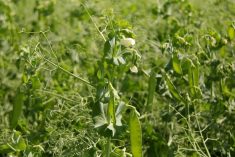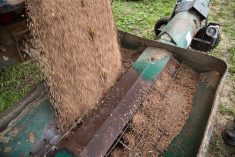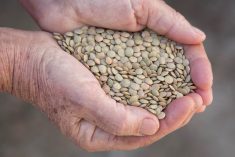Rain makes grain, the saying goes — but too much spring rain and farmers are likely to see disease in pulses.
That’s certainly been the case in Saskatchewan, where farmers in most regions are actively scouting for, or in some cases spraying for, crop diseases, according to the provincial crop report.
So which leaf diseases should pulse growers watch for? And what are the management options? Dr. Sabine Banniza, plant pathologist with the University of Saskatchewan, reviewed the major pulse diseases in a recent Saskatchewan Pulse Growers webinar.
Read Also

India slaps 30 per cent import duty on yellow peas
India has imposed a 30 per cent duty on yellow pea imports with a bill of lading date on or after Nov. 1, 2025.
Anthracnose — Anthracnose is the number one disease for lentil growers in Saskatchewan these days, Banniza said. Lentil growers should look closely for brown or beige lesions. Once the disease is more established, farmers are likely to see leaf drop. Lesions can eventually girdle the plant, killing it, she added.
Resistant lentil varieties are available; however, she said, they are only resistant to race one. Race zero, the more aggressive and common anthracnose strain, can overcome those resistant varieties. Lentil breeders hope to have race zero resistance “in a short period of time,” she said.
Ascochyta blight — “Of all the pulse crops, I would say ascochyta blight in chickpeas is the most aggressive. It spreads very, very fast and you really have to be on top of managing that disease,” said Banniza.
The disease can also infect faba beans and lentils. Mycosphaerella blight, an ascochyta disease, hits peas, too. Although each crop species is susceptible to a different ascochyta species, they look similar, said Banniza. Farmers should watch for lesions with a darker border and spots in the centre.
In faba beans and chickpeas, the disease can look similar to herbicide damage, so farmers should think about field history and recent weather when trying to diagnose the problem.
Stemphylium blight — In lentils, stemphylium blight starts out as light beige lesions. Those lesions eventually merge, turning the entire leaf brown. Leaf drop also occurs.
Conducting field research on this disease is difficult because spores are airborne. But Banniza said their research shows early to mid-flower infections may cause yield loss, seed stain, and seed infection in lentils.
Often stemphylium blight shows up late in the season. Late infections probably don’t do much damage, Banniza said. In fact, very late infections may work as a natural desiccant, defoliating lentil leaves, she added.
Sclerotinia and botrytis — Sclerotinia white mould and botrytis grey mould are relatively easy to diagnose. As their names suggest, they cause a “cottony white” or “fuzzy grey” mould on the plants stems, leaves, flowers, and pods, Banniza said.
Very wet conditions favour these moulds. Lentil growers with very thick, lush stands are more likely to see these diseases late in the season, especially if the crop lodges. Faba beans and chickpeas can also be infected by sclerotinia white mould.
Chocolate spot — Faba beans are susceptible to a specific species of botrytis grey mould, known as chocolate spot in this crop. Banniza said the disease can be “very devastating” if conditions are wet.
Chocolate spot can develop very quickly, causing defoliation and even lodging. Initial symptoms are tiny reddish lesions. Those lesions enlarge, coalesce, and turn the entire leaf brownish-black.
Banniza cautioned the disease can be confused with herbicide damage. Farmers need to think about weather patterns when diagnosing the problem, as it’s a rain-driven disease. They can also send tissue samples to a lab, she added.
Tips for managing disease
A four-year rotation is an effective way to reduce most of the leaf diseases, as it reduces the inoculum in the fields, Banniza said. However, airborne diseases such as stemphylium blight can’t be managed through rotation, she added.
Scouting is also crucial. Foliar diseases tend to start at the bottom of the plant, Banniza said, so it’s not good enough to glance across the field. Banniza also recommended paying more attention to high-risk fields — for example, wet fields, as well as fields with dense canopies or lodging crops.
Because ascochyta blight is so aggressive in chickpeas, Banniza recommended a preventive fungicide application very early in the season. Whether or not chickpea growers will need to spray again will depend on weather and disease symptoms. Banniza suggested reviewing the SaskPulse fungicide application checklist.
Lentil growers can manage many of the leaf diseases the same way, Banniza said.
“If you see lesions early on in your (lentil) crop, and conditions are conducive to infection, it doesn’t matter whether it’s an anthracnose lesion or an ascochyta blight lesion or a stemphylium blight lesion. You will follow the same disease management categories.”
Lentil growers should be scouting early, and if a fungicide application is warranted, spraying at the eight- to 10-node stage, she said. Sask Pulse has a fungicide application checklist available online.
If lentil growers see more wet weather, they should consider a second fungicide application in three weeks, says Banniza. The application efficacy from the first application will decline in two or three weeks. New growth will also be unprotected, she says.
Fungicide efficacy for mycosphaerella blight in peas is variable, according to several field trials done by various research groups, Banniza said. “You can’t predict, it appears, whether a fungicide application really translates into a yield gain.”
For pea growers facing a mycosphaerella blight infection, spraying may be more of an economic decision, she said.
Banniza doesn’t recommend fungicide applications for sclerotinia white and botrytis grey mould in lentils, either. Because the diseases infect thick lentil stands late in the season, the fungicide is unlikely to penetrate enough of the crop canopy to make a difference, she explained.
“The best option is to manage your (lentil) canopy. But that’s obviously very tricky because when you seed it, you don’t know what the growing season will look like,” said Banniza.
As for faba beans, fungicide application is “an important tool,” Banniza said. If farmers see disease symptoms during flowering in the lower canopy and weather conditions favour disease, application is warranted, she says. The most yield potential is in the middle of the faba bean plant, so farmers should try to protect that area, she said.
A free version of the Crop Protection Book is available through Alberta Agriculture’s website.
— Lisa Guenther is a field editor for Grainews and Country Guide at Livelong, Sask. Follow her at @LtoG on Twitter.
CORRECTION, Aug. 2 2016: A previous version of this article incorrectly stated ascochyta blight looks similar to herbicide damage in chickpeas as well as faba beans.













